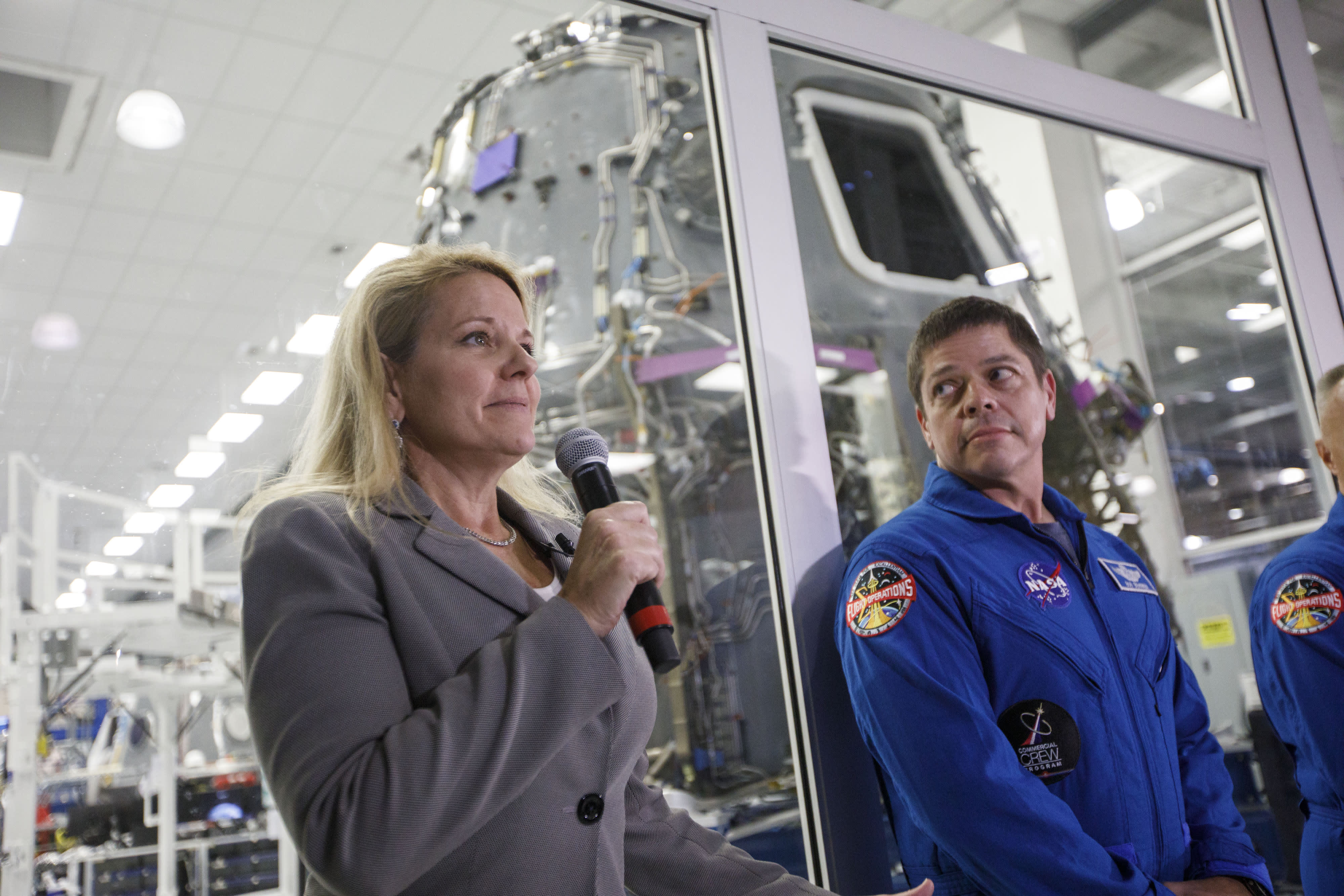SpaceX wants to land Starship on the moon within three years and people soon after

NEW YORK CITY – SpaceX President and COO Gwynne Shotwell outlined plans for its two development programs at a recent investor conference, giving her forecast for when the company will fly people on its next-generation rocket and begin offering internet from its satellite network.
The company has raised more than $1.3 billion this year to build both Starship, the massive rocket it wants to use to fly people to the moon and Mars, and Starlink, a network of as many as 30,000 satellites to provide high speed internet. SpaceX is building multiple Starship rockets at once, as founder Elon Musk has the company on an ambitious timeline to begin launching Starship regularly and prove that it can be reused easily, like an aircraft.
Gwynne Shotwell, president and chief operating officer of Space Exploration Technologies Corp. (SpaceX), left, speaks as NASA astronaut Bob Behnken looks on during the NASA Commercial Crew Program (CCP) astronaut visit at the SpaceX headquarters in Hawthorne, California, U.S., on Monday, Aug. 13, 2018.
Patrick T. Fallon | Bloomberg | Getty Images
Shotwell, speaking at Baron Fund's annual investment conference at the Metropolitan Opera House on Friday, gave an update on SpaceX's goals for Starship.
"We want Starship in orbit next year; we want to land it on the moon before 2022 with cargo and with people shortly thereafter," Shotwell said.
However, much like Musk in his presentation last month, Shotwell hedged her estimate, saying that "every time I make a prediction about schedule I turn myself into a liar." Most of SpaceX is focused on the company's Crew Dragon capsule, which is undergoing a final series of tests before it flies two NASA astronauts.
"It's a critical program for us, as it's our first step to flying astronauts," Shotwell said.
Shotwell said SpaceX wants to fly Crew Dragon frequently so the company can learn as much as it can about flying people safely. While SpaceX has dozens of successful rocket launches under its belt, it has yet to fly astronauts. The first Crew Dragon flights will go to the International Space Station – much like the uncrewed test mission SpaceX performed with the capsule in March – and will be an important step toward its grander ambitions.
"Then we'll put people on Starship and send them to farther places," Shotwell said.
An animation of SpaceX's rocket Starship launching through the Earth's atmosphere.
SpaceX
Once complete, Starship will be an immense rocket as SpaceX designed the rocket to carry as many as 100 people. But, more importantly, the company is applying the lessons its learned landing rockets to make Starship fully reusable, Shotwell explained.
"If you're going to take people to other planets, you can't wait for a new aerospace industry to develop on the planet before you can figure out how to land a rocket. You have to figure out how to land, refuel, and come back," Shotwell said.
SpaceX has successfully recovered 44 boosters from its Falcon 9 and Falcon Heavy rockets. But while the booster recoveries have been a step forward in rocketry, it only represents the bottom portion of the rocket. SpaceX wants to recover both Starship, which will be the upper part of the rocket, and its Super Heavy booster.
"So we're not going to waste anything ... all we'll spend money on is fuel," Shotwell said.
Starship to launch 400 satellites at once
But Starship will feature in the company's plans in more ways than just exploration. Shotwell revealed that SpaceX plans to use the new rocket to deploy its Starlink network even more quickly than it is already.
SpaceX launched the first 60 Starlink satellites in May, packing them into the top of a Falcon 9 rocket. And, just before the launch, Musk told reporters that SpaceX has "sufficient capital" to get its Starlink satellite network "to an operational level."
"In the next few weeks we're going to launch another 60 and then get to a cadence of launching 60 every other week to fill out the constellation," Shotwell said.
"We need 360 to 400 to have a constant connectivity where the satellites can end up through the ground talking to each other. Once we get to 1,200 satellites, we will have coverage of the whole globe," Shotwell added.
SpaceX deploys its 60 Starlink satellites simultaenously.
SpaceX | GIF by @thesheetztweetz
Once SpaceX is flying Starship regularly, she said the rocket will be able to launch nearly seven times as many Starlink satellites at once.
"Starship can take 400 satellites at a time," Shotwell said.
SpaceX and its investors see Starlink as the key to funding Musk's vision of colonizing Mars. Shotwell said the company's board of directors in 2012 realized the profit margins from the commercial satellites it was launching for customers were "much higher" than SpaceX's launch business. Musk estimates Starlink could generate more than $30 billion per year – at least 10 times what SpaceX could bring in at best from its launch business.
Shotwell also noted that completing the Starlink network will cost less than some estimates. Morgan Stanley last week said it would cost about $60 billion for SpaceX to launch 30,000 Starlink satellites, an estimate Shotwell dismissed.
"They were way off," Shotwell said.
Unlike traditional satellites, Starlinks will have limited lifespans of about five years, Shotwell explained. SpaceX will "refresh the technology" of the Starlink network by rapidly replacing the satellites, which are designed to intentionally burn up in the Earth's atmosphere.
"The satellites will be limited in their life because the longer you want the satellites to live on orbit the more money you put have to put into it," Shotwell said. "We will be continually launching these satellites to refresh the technology, to address any issues with the satellites, to put up ones that are working better in its place."
Read More
No comments